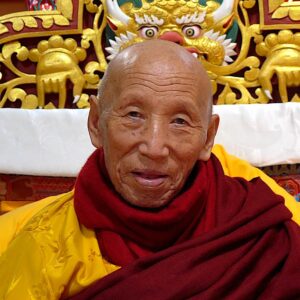Learning meditation requires both study and actual practice. Correct preparation before starting a meditation session allows us to experience authentic results. In this audio excerpt from an introductory Mahamudra retreat in Vietnam, Phakchok Rinpoche explains why we need to prepare before we sit and meditate.
(The first audio file is translated into Vietnamese and English and the second one is English only.)
Audio English Only
Mahamudra Meditation
In this audio, Rinpoche explains the Sanskrit term Mahamudra (literally “Great Seal”) in a unique and non-literal way. Mahā (Great) can mean “all”. And we can understand mudrā to mean “seeing the truth”. We benefit from seeing and understanding correctly. When we start off on a journey, we need to see the road. Likewise, when we learn meditation, it helps to develop the right understanding. A traveler not only needs to see the road but should have a sense of the destination or goal.
A Balance of Knowledge and Practice
If we meditate without proper understanding, we probably won’t do it correctly, and won’t make much progress. But on the other hand, if we think learning meditation means that we read many books and study a lot, but don’t actually practice meditation, then that also rarely brings success. So we should aim for a balance of knowledge and practice to get results.
As meditators, we face a funny challenge. We hear often that we need a sense of urgency–to want to get fast results from our practice. But, crucially, we should not hope or attach too much to those results. That may sound strange, but as we accustom ourselves to practice this seeming contradiction will make sense.
Correct Preparation in Three Steps
Rinpoche explains that if we take the time to prepare correctly before we meditate, our progress will be steady and swift. He divides these into three key points. We’ll list these first and then review each one.
- Reflect that all sentient beings have the same nature of mind. And also reflect that this nature IS Buddha
- Practice supplication, giving rise to bodhicitta and reflecting on impermanence
- Prepare physically for meditation
First: The Nature of Mind of All Sentient Beings is Buddha
We can describe this nature as the ground. Although this is true, we may lack confidence in this reality. But, we can come to recognize and have deep faith in this ultimate truth. How do we build that confidence?
Through habit. We repeat that phrase again and again until we gain confidence and faith that is true. Before we sit to meditate, we say: “The nature of the mind of all sentient beings is Buddha-nature”.
Don’t worry if you feel slightly silly at first! Yes, you may be faking confidence you do not feel. But if you repeat this regularly, you will experience a shift in your skeptical attitude.
Second: Supplication, Bodhicitta, Impermanence
The Buddha, in the Mahāyāna Samādhirāja Sūtra (also known as the Candrapradīpa Sūtra), teaches these three steps that a meditator can employ to gain meditative concentration or samādhi. Here Rinpoche expands on the explanation and gives practical tips for how to approach these key steps
- Supplicate all the buddhas and ask for their blessings. The Buddha himself explained that he did this in his many past lives by making countless offerings to all the buddhas. Rinpoche advises us that we should make physical offerings such as lamps or flowers before we practice. But if we cannot, then at least we should take the time to make mental offerings. And imagine that all this happens instantaneously. Feel a great conviction that you make the offering, the buddhas receive it, and they send forth blessings for your meditation. Be decisive that this occurs!
- Give rise to bodhicitta–the wish that all beings may be free from suffering and attain awakening. Direct your eyes — the gaze — into empty space. Merge your mind with that vastness, feeling inseparable from space. Then think that wherever space reaches, your compassion reaches. Think that your compassion reaches all sentient beings who suffer from confusion. They suffer because they do not see the truth. Give rise to the wish to free them all from this suffering — that all their obstacles are removed and that they come to see just as all the buddhas see.
- Recall impermanence. Remember that all beings are subject to death. We never know how long we have. Reflect that now you have the great opportunity to practice Dharma. And resolve to do this now with 110% of your effort.
Third: Learning Meditation Posture

- Place your hands on the knees, palms down loose and relaxed
- Back straight (but not rigid) and shoulders relaxed
- Mouth slightly open
- Eyes gently open but not staring fixedly
We have a choice of three gaze positions. Your gaze can be gently down toward a space in front of you (this is usually suggested when we begin to practice meditation). A downward gaze works well if we are agitated or have many thoughts.
Alternatively, we can gaze straight ahead or we can slightly raise our eyes. Raised eyes may aid us if we feel sleepy or dull. We should not move the head, but only adjust the eyes themselves. Once we choose a gaze we can rest our eyes softly in that position and avoid looking around us.










Responses